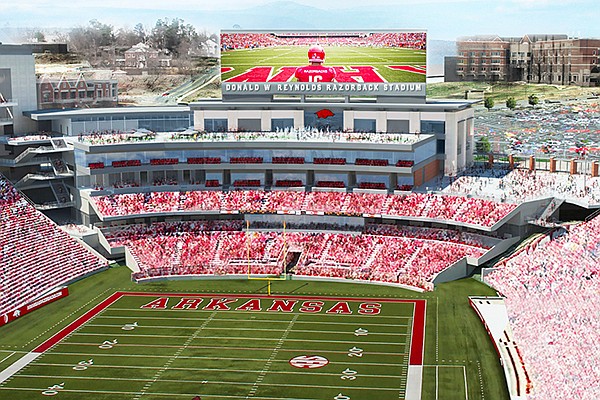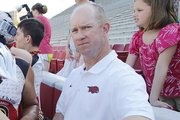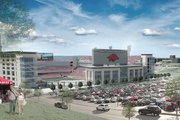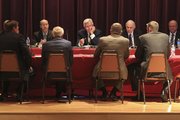FAYETTEVILLE — Many fans were set to get their first in-person view of construction to Arkansas' football stadium Saturday when the Razorbacks play their annual Red-White Game.
That won't happen now that Arkansas has closed its final spring scrimmage to the public, but the site work still might be an angle on the SEC Network telecast at noon.
Those who drive by the corner of Razorback Rd. and Maple St. see construction on the north and south ends of Donald W. Reynolds Razorback Stadium - more so on the north where crews are doing groundwork for the addition of about 4,500 mostly club-level seats. The "hole," as the north side is referred to by some in the athletics department, is a conglomeration of dirt and concrete where a defined steel structure will be visible by the time football season begins in September.
A video board is being installed above the south end of the stadium and work soon will begin on the east side where the athletics department's old academic center is being turned into another series of suites and club space that will accommodate around 300 people on game days.
If all goes according to plan Arkansas will play its first game in the renovated stadium on Sept. 1, 2018, when the Razorbacks are scheduled to host Eastern Illinois.
Inside Bud Walton Arena, Matt Trantham monitors the construction from a live feed on a TV hanging from his office wall. Trantham, the University of Arkansas' senior associate athletics director for internal operations, is overseeing the day-to-day operations of the stadium renovation, in coordination with architects Populous and Polk, Stanley, Wilcox.
This is the eighth full project in the Razorbacks' master facilities plan that Trantham has overseen, but easily the largest. The $160 million renovation will take about 22 months from ground-break to polish, but has been in the works for about eight years.
It was shortly after Trantham arrived with new athletics director Jeff Long in 2008 that Long began preparing a road map for upgrades to several of the Razorbacks' facilities. In 2011, Long unveiled his master plan - a comprehensive study that included projected costs and renderings for 14 new buildings or renovations to existing ones located on and off campus.
"Jeff was motivated to say we've got some great facilities across the board for all our sports, but you've got to keep up in the SEC and there probably were some areas we needed to focus some attention on," Trantham said. "You get into facilities and it can be focused toward fan experience, capacity and all those things to host an event, versus some that are focused more toward the student-athlete experience, so he quickly assessed we needed a road map for what we were going to do for all our facilities that wasn't just focused on a piece here and piece there."
The most notable addition to the master plan was the expansion to the 72,000-seat football stadium, which at the time was projected to cost between $78 million and $95 million.
But when the university's board of trustees commissioned a feasibility study in 2013, administrators quickly realized they had underestimated the scope of the project. Primarily, they did not expect to need to demolish their own offices in the Broyles Athletic Center on the stadium's north side.
The Broyles Center, built in the 1970s, was demolished last December and will be rebuilt on the same site.
"The Broyles Center wasn't built with the ability to build on top of it," Trantham said. "So when you started looking at all of what you were going to need to sacrifice when you talk about connectivity to the existing stadium, how it would flow, how it would add to our amenities by keeping the existing Broyles, it just didn't look like a good long-term plan for a stadium that's going to be here for 50-plus years to build around a building that already was old to begin with."
Construction costs also have been affected by the population boom in the Northwest Arkansas metro area, which, according to the U.S. Census Bureau, grew by more than 50,000 residents between 2010-2015, making it one of the country's 25 most rapidly growing regions.
The region grew by more than 11,000 residents in 2014 alone after cities such as Fayetteville, Bentonville and Siloam Springs made national lists as top 10 places to live.
"Truthfully our market has gone up pretty strong," Trantham said. "The costs have gone up pretty significantly from those market prices (of 2011)."
What's New
A relatively mild winter in Northwest Arkansas allowed construction crews to get ahead of schedule on the stadium project, which helped when the rainy season set in this spring.
"Right now we'd say we're on schedule," Trantham said. "Weather is always going to have an impact, especially when you have an open hole like this, but right now the weather has been very favorable for us staying on schedule."
The exterior of the project is expected to be finished by next March, with the work during the remaining months spent on interior spaces. Trantham said he hopes to have the "keys to the stadium" by Aug. 1, 2018, which would allow one month to prepare for the grand reopening.
"I can tell you this: because part of this project is that office area (in the Broyles Center), we're all on the same page that if there's an area where we're going to be behind, it's going to be that because we're going to be ready for game day," Trantham said. "We've got seats sold and we're going to want to host folks for a wonderful experience that first game, so if there is something that gets delayed, it's going to be folks moving into their office space."
Once completed, Arkansas' football stadium will add 38 new suites to the 134 existing suites, many of which were built during a 2001 renovation and are sold out each year. According to figures provided by the athletics department, 98 percent of club and suite seats were sold last year, which accounted for 37.6 percent of the Razorbacks’ $31.9 million in ticket sales.
Each new suite requires a seven-year commitment, said Scott Varady, executive director of the Razorback Foundation, and a donation of about $3,700 to $4,100 per seat each year. Each suite will be able to accommodate 18 to 30 people, including six standing-room only tickets. Each suite will include access to a club area with "all-inclusive food and non-alcoholic drinks," Varady said, as well as multiple parking passes - a number that varies on the suite level.
The foundation, the private fundraising arm for the athletics department, has secured commitments for 31 of the 38 suites, Varady said, and expects to have commitments for all 38 by the 2018 season because of a change in how the suites are offered.
"Our existing suites, we had a waiting list and people had to go on priority of membership level and priority points they have accumulated over their lifetime of giving, but with the new suites people were able to join the program but they didn't have to have a history of prior giving," Varady said. "You can come in and get a suite today without having that history of prior giving."
The north end zone suites will be structured much like the ones at Baum Stadium, Varady said, with accordion windows and outdoor and indoor seats. No existing suites at the football stadium offer outdoor seating.
Unlike Baum Stadium, the back of the north end zone suites will open up into an indoor club area creating a "social-suite atmosphere," Varady said, in which suite ticket holders can roam from one box to another.
Arkansas administrators toured stadiums at Texas A&M, Baylor, TCU and Minnesota prior to and during the design phase. A number of field-level suites are designed after AT&T Stadium in Arlington, Texas, where the Razorbacks play Texas A&M each September.
"Any time we were on the road and had the chance to see a new stadium or a renovation, we were pretty keen to get a look at it, or at least talk to people who were part of that," Trantham said. "We've been able to talk to a lot of folks in regards to the design we came up with.
"I think we've done a good job of living within our means and doing what we're financially capable of."
One key design element is the addition of loge boxes, which are small, four-seat club areas that include a parking pass, food and drinks, and access to indoor club areas.
"We haven't started seeking donations on the loge boxes yet, but I anticipate that will be upcoming this summer," said Varady, who noted the donation level for loge boxes has not been determined. "When we visited Baylor and A&M, the feedback we got back from the officials of those institutions was that their loge boxes were wildly popular among their fans."
Other new features include quadrupling the number of stadium elevator shafts from one to four, which will provide access from the field level to the top of the stadium for the first time; renovation of all existing suites; a video board atop the south end zone that will be ready for the 2017 season; and new game-day locker rooms, administration offices and a media center in the rebuilt Broyles Center.
What's missing from the project is the addition of general-admission seating, although around 1,500 standing-room only tickets will be sold on top of the north end zone structure. Chad McEvoy, a Northern Illinois University professor who studies attendance trends, said it isn't surprising that Arkansas is putting a greater emphasis on the quality of seating than a large quantity.
"There is evidence to suggest that attendance might be going down among younger fans and students in particular, but the demand is still very high for a premium customer," McEvoy said. "While it may not make sense to add tens of thousands of seats to a stadium, it makes sense to add a few-thousand premium seats.
"The Major League Baseball teams that have built new stadiums in the past 10 years are building smaller stadiums and ones with more premium opportunities. That looks like a model that we might see in college football and basketball and elsewhere in the coming years. We could see new or renovated stadiums seating thousands fewer fans, but having more premium opportunities."
McEvoy notes average attendance has declined nationwide at college football games the past six seasons - an era that correlates with most major conferences signing long-term TV agreements to include all football games. The SEC Network is worth $14 million per year to each school, Long told the university's board of trustees last year.
"One of the biggest competitors to attendance is fans enjoying the game at home on their 60-inch, high-def TV with virtually no costs other than equipment and cable or satellite packages they may already possess," McEvoy said. "There are no parking costs at home and the food is cheaper at home and the beer is cheaper at home. To some degree or another, that living room experience becomes our own competition.
"However if football is down a couple-thousand tickets sold, that's more than offset by those strong TV revenues coming in."
With aggressive ticket-selling strategies, Arkansas has bucked the national trend and increased ticket sales the past three seasons, including a 4.3 percent increase between 2015 and 2016 when ticket prices for upper-level seating areas were decreased and the Razorbacks played a loaded home schedule that included Alabama, LSU, Florida and Ole Miss.
"When you lower ticket prices throughout the stadium, lower concession prices - which were done through a survey - people are very attentive to that," Varady said.
Building for the Future
There was some thought, albeit brief, to building a new football stadium.
"When we were in the middle of the master plan, someone said, 'Hey, why are we not talking about moving the football stadium and Bud Walton Arena somewhere else? Move it off-campus and build it somewhere new,'" Trantham said. "Frankly, we shut that conversation down pretty quick. There was no interest in moving off campus. Our facilities, as it relates to our students and our campus, I think our patrons enjoy coming to campus and it's an important part of our fabric."
By the time the renovation is complete, Razorback Stadium will be in its 80th season of operation, although virtually none of the original stadium exists anymore after a series of renovations throughout the decades.
The stadium was opened in 1939 and was built as a Works Progress Administration project. The stadium originally was called Bailey Stadium after Arkansas Gov. Carl Bailey, but the name was changed to Razorback Stadium in 1941 after Bailey was defeated in a reelection bid.
The stadium took its current shape and added Donald W. Reynolds' name after an expansion that was completed in time for the 2001 season, which added about 22,000 seats on the south and east side, including several new club seats in the south end zone.
Unlike this project, the 2001 renovation didn't have to take into consideration future building plans because the north end zone still was an open space, minus the Broyles Center and a large video board structure installed prior to the 2000 season.
That video board structure had to come down along with the Broyles Center late last year. The video screen previously on the north side is being installed above the south end zone this spring and should be operational by June, Trantham said. Another video screen with the same dimensions will be installed on the north end by July, Trantham said, although the structure will be closer to the field than between 2000-2016.
The video board is being rebuilt, in part, so that future expansions can be built around it. There are multiple areas on the north end that officials think could be filled in if the demand arises.
"We built into that structure the capabilities of adding some bleacher seating above that deck," said Trantham, referencing a standing-room only area just below the north video board.
There also is the gap in the northeast corner of the stadium that provides a view into the stadium from the outside.
"It became apparent early in the conversations that we wanted to keep that opening," Trantham said.
But "if someone down the road wanted to do it, they could fill in that bowl," Varady said.
As part of the Broyles Center rebuild, areas previously available to the team on game day won't be available during the 2017 season. That means the football team will utilize the usual visitor locker room in the coming season, one of a number of logistical challenges facing the university's administration.
"We're still working through where the visiting team is going to go," Trantham said. "We've got some space we may have to adjust for that purpose.
"We may have to use Barnhill (Arena) for some of those pieces, but we anticipate right now that our team will come out of the southwest corner like the visiting teams did, and the visitors will come out of the southeast and go right up their sideline."
The game-day locker rooms will be the second new locker room built for football players in less than five years. The Fred W. Smith Center construction also included spacious locker rooms for the team to use throughout the year. Trantham said it wouldn't be feasible for the football team to use their everyday locker rooms on game day, even though the Smith Center is located adjacent to the south end of the football stadium.
"It's really not that easily accessible when you talk about the amount of time you have during warmups to go out on the field and halftime," Trantham said. "The way it's constructed you'd have to go down a ramp, through a loading dock and really having to go a long ways.
"There also is an element of maintaining traditions like the pregame 'Hog Walk,' running through the 'A' from the north end - that all was important for us to maintain. When we looked at the logistics of that and the traditions that we wanted to maintain, it really made sense to keep the (game-day) locker room where it was."
Football Costs
Some of those amenities like a second locker room made the $160 million price tag a source of contention as the Razorbacks spent much of 2016 attempting to clear their biggest hurdle - the university's 10-member board of trustees, in particular former U.S. Sen. David Pryor.
Pryor was an outspoken critic after the university requested $120 million in bonds to fund construction. The Razorbacks committed to contribute the other $40 million upfront and said $19 million is built into the figure for the project as cost overruns.
The bonds are scheduled to be paid back over 20 years at a cost of $9 million to $10 million per year.
Arkansas' athletics department carried $56.5 million in debt in fiscal year 2016 - the second-lowest amount of any SEC program. More than $38.6 million of that debt is the result of completed projects outlined in the 2011 master plan.
Pryor and C.C. Gibson voted against the expansion last June and five former trustees, including John Tyson, wrote a guest editorial in the Northwest Arkansas Democrat-Gazette that called the project "too much, at the wrong time," while referencing issues facing higher education, such as rising tuition costs.
"That's not exclusive to just Arkansas," McEvoy said. "In many states across the country, funding for higher education is down so you sometimes run into a situation where budgets may be in the process of being cut on the academic side of a university, while at the same time peers across campus in athletics are spending hundreds of millions on facilities.
"It puts some tension into the mix when there is a disparity between budgets on the academic versus the athletic side."
Officials say much of the $120 million to pay back the bonds would not be available without increased seating, so any argument that the renovation money should be used on academics is flawed.
They also point to the fact the athletics department transferred $2.335 million back to the university last year as part of several projects to benefit non-athletes.
For instance, the athletics department pledged $23 million toward a 30-year note for a $26.5 million classroom building in 2015, and paid around $4 million over a two-year span to provide about 800 parking spots on the west side of Razorback Rd, which replaced some parking lost to new athletic facilities. Trantham said more than 100 parking spaces will be permanently lost as part of the football stadium renovation and more will be lost in future years when the Arkansas Highway Department widens Maple St. on the stadium's north side.
Central to the athletics department's argument is that the renovation will be paid back through ticket sales, media rights agreements and private donations, and without using any student fees as many peer institutions utilize to subsidize athletic budgets.
Arkansas is the latest in a rapidly-growing number of schools that has renovated or built stadiums in the past decade. Every SEC program has had some sort of stadium renovation since 2010 as team revenues soared by virtue of the league's association with ESPN, the parent company of the SEC Network.
Arkansas' football team was worth $56.5 million in revenues last year.
"It's been labeled as an arms race in college athletics," McEvoy said. "Who can build the biggest and the best, and generate the most revenue and resources? That then gets funneled back in the system and really self-perpetuates. You generate more revenue that allows you to attract better coaches, recruit better players, which makes more revenue and the cycle continues."
The increasing value of the football team has led to construction that benefits the sport away from the stadium. The Fred W. Smith Center, which houses offices, locker rooms and meeting rooms for the football team, opened in 2014.
That project - which included the building of two new outdoor practice fields and an underground parking garage - cost around $45 million. It was essential to make football-related activities more efficient for players, Trantham said.
"The functionality of our program was just inefficient with its current facility," Trantham said. "Recruiting is a big part of that. The fact that building is now connected to where they lift weights, the indoor facilities, the practice fields, the efficiency of the student-athlete and our coaches' ability to train and compete in that building was of vital importance to that."
Arkansas also spent greater than $4 million on a new high-definition video screen, ribbon boards and audio enhancements at the football stadium prior to the 2012 season, and in 2009 spent about $1.1 million on a turf field that likely will be replaced following this season because of impact related to construction, Trantham said.
On top of the record spending for facilities, Arkansas - like most major college programs - is spending record amounts for its personnel. Since 2010, the Razorbacks' full-time football coaches - one head coach and nine assistants - received a cumulative pay increase from $4.795 million to $8.145 million this year. The NCAA will allow programs to add a 10th assistant coach next January.
"You can look at our annual revenue and the importance of football tickets and donations, and where that emphasis goes," Trantham said. "The stadium was one of those facilities that had to be near the top of the list to keep it relevant and continue to provide the type of facilities that our patrons should expect when they pay what they do to come watch a football game."





